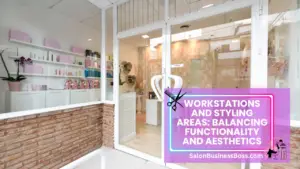When it comes to creating an inviting and efficient environment for a beauty salon, the floor plan design plays a pivotal role. A well-designed salon floor plan not only enhances the overall aesthetics but also ensures optimal functionality and a seamless customer experience.
A beauty salon floor plan design includes strategic placement of reception areas, workstations, and private treatment rooms. Thoughtful flow and lighting ensure a seamless customer journey, while a balanced color palette and design elements enhance aesthetics. Flexibility for future growth ensures a salon that adapts to industry trends.
The Importance of Layout
The layout of a beauty salon serves as the foundation for the entire customer experience, making it a crucial aspect of successful design. A thoughtfully planned layout creates a harmonious environment where clients and staff can engage comfortably and efficiently. A spacious and well-organized layout goes beyond aesthetics; it cultivates a sense of relaxation and ease throughout the salon.
In particular, a well-considered layout guarantees that various sections of the salon are easily accessible, promoting a seamless flow of movement. By eliminating potential bottlenecks and congestion points, clients can navigate the space without hindrance. This strategic arrangement enhances the overall atmosphere and ensures that clients feel at ease from the moment they step in.
The impact of a well-designed layout extends beyond the physical aspects. It influences the psychological perception of space, fostering a tranquil and welcoming ambiance. As clients move through the salon effortlessly, they experience a heightened sense of relaxation and comfort, allowing them to fully engage with the salon’s offerings.
Reception Area: The Welcoming Gateway
The reception area serves as the salon’s first impression—a vital touchpoint that sets the tone for the entire client experience. Placing the reception area near the entrance creates a natural and inviting pathway for clients. This strategic positioning ensures a warm welcome and immediate access, demonstrating a customer-centric approach.
To create an inviting ambiance, it’s essential to curate the reception area with careful attention to detail. Comfortable seating offers clients a cozy space to await their appointments, while elegant decor elements contribute to an upscale and sophisticated atmosphere. The reception desk, designed with functionality and aesthetics in mind, further reinforces the salon’s commitment to a seamless experience.
In essence, the reception area becomes more than a practical space—it evolves into a welcoming gateway that leaves an indelible first impression on clients. By prioritizing comfort, aesthetics, and accessibility, salon owners can establish a positive and lasting connection with clients right from the outset, setting the stage for a memorable and satisfying salon visit.
Workstations and Styling Areas: Balancing Functionality and Aesthetics

Striking a harmonious equilibrium between functionality and aesthetics within workstations and styling areas is pivotal in ensuring a seamless salon experience. These areas are the heart of client interaction, demanding a design that facilitates staff efficiency while nurturing a welcoming environment.
Efficient arrangement of workstations is a cornerstone for a smooth workflow. Providing ample space for hairstyling, makeup application, and other services not only enables staff to work comfortably but also gives clients a sense of openness. This design consideration contributes to a positive perception of the salon’s spaciousness and elegance.
The significance of adequate lighting cannot be overstated. Proper illumination is essential for staff to execute their tasks with precision, ensuring the highest quality services. Moreover, lighting contributes significantly to the overall ambiance, allowing clients to feel confident and at ease in the salon’s surroundings.
Read more about: Navigating the Regulatory Landscape: Requirements to Open a Hair Salon
Storage Solutions: Keeping the Clutter at Bay
n the realm of salon floor plan design, the incorporation of efficient storage solutions is often underestimated but integral. Cabinets, shelves, and storage rooms play a crucial role in maintaining a clutter-free environment, promoting an atmosphere of professionalism and orderliness.
Strategically positioning storage units near workstations minimizes distractions for staff, enabling them to concentrate fully on delivering exceptional services. Organized storage ensures quick access to essential equipment, products, and tools, fostering a seamless workflow. Moreover, it enhances the aesthetic appeal by concealing clutter and presenting a clean, uncluttered space to both staff and clients.
Optimizing workstations and styling areas marries functional efficiency with aesthetic allure. Proper lighting and thoughtfully designed storage solutions contribute to the overall allure of the salon while supporting staff excellence and client contentment. This delicate balance, when achieved, transforms workspaces into engaging, comfortable, and visually appealing zones that epitomize the essence of a beauty salon’s charm.
Private Treatment Rooms: Retreats of Tranquility
Incorporating private treatment rooms within a beauty salon’s floor plan introduces an unparalleled level of indulgence to the client journey. Tailored for services demanding privacy and relaxation, such as facials or massages, these rooms offer a serene retreat away from the bustling salon environment. The strategic placement of these rooms away from high-traffic areas ensures a tranquil ambiance, fostering an atmosphere of serenity and escape.
Soft lighting plays a pivotal role in creating the perfect mood within these secluded sanctuaries. Subdued, gentle lighting sets the tone for relaxation, enabling clients to unwind and rejuvenate fully. Complemented by soothing colors that evoke a sense of calm, and comfortable furnishings designed for ultimate comfort, private treatment rooms become cocoons of tranquility.
Lounge and Waiting Areas: Comfortable Interludes
Lounge and waiting areas within a salon’s floor plan contribute significantly to the overall customer experience. These designated spaces serve as interludes where clients can unwind, connect, and immerse themselves in the salon’s inviting atmosphere.
To ensure comfort and relaxation, these areas should be equipped with plush, comfortable seating that encourages clients to settle in. Providing a selection of reading materials and refreshments transforms these spaces into welcoming havens of respite. By creating an environment that promotes relaxation and connection, lounge and waiting areas establish a sense of community within the salon, allowing clients to share their beauty experiences and forge connections.
Private treatment rooms and inviting lounge areas embody the essence of an exceptional beauty salon experience. The creation of tranquil retreats for private services and the establishment of cozy waiting areas for clients amplify the salon’s commitment to providing holistic comfort, relaxation, and rejuvenation. Through thoughtful design, these areas seamlessly integrate into the salon’s narrative, inviting clients to indulge in a comprehensive journey of beauty and relaxation.
Flow and Traffic Considerations

A successful beauty salon floor plan goes beyond aesthetics, prioritizing the smooth flow of clients and staff throughout the space. Thoughtful consideration of the pathways from the entrance to various service areas is essential to prevent congestion and confusion. By strategically designing clear and unobstructed pathways, the salon ensures that both clients and staff can navigate seamlessly.
A well-planned flow contributes to the overall efficiency of the salon experience. Clients can move effortlessly from reception to their desired service areas without encountering barriers or delays. This enhances not only the operational aspect of the salon but also the overall enjoyment of clients, as they can focus on their treatments rather than navigating a maze.
Read more about: Navigating the Regulatory Landscape: Requirements to Open a Hair Salon
Lighting and Ambiance
Lighting serves as a fundamental tool in shaping the ambiance and mood of a beauty salon. The incorporation of natural light, whenever possible, infuses the space with a sense of freshness and vitality. It establishes a connection with the outdoors, contributing to an inviting and vibrant atmosphere.
Integrating various lighting elements further enriches the salon’s ambiance. Pendant lights, track lighting, and mirrors with integrated lighting create layers of illumination, adding depth and dimension to the space. These elements allow for adaptable lighting schemes, accommodating different treatments and creating a dynamic environment that evolves throughout the day.
The thoughtful consideration of flow and lighting in a beauty salon floor plan design significantly influences the overall experience. A well-planned flow guarantees efficient movement, while lighting shapes the desired ambiance, enhancing the salon’s visual appeal and fostering a welcoming and engaging atmosphere for both clients and staff.
Color Palette and Design Elements
The selection of a thoughtfully curated color palette and design elements in a salon floor plan goes beyond mere aesthetics—it shapes the overall atmosphere and impression clients experience. A coherent color scheme that harmonizes with the salon’s branding and style imparts a sense of visual cohesion, enveloping visitors in an environment that is both pleasing and consistent. Such a palette serves as a canvas upon which the salon’s identity is vividly painted, immersing clients in a sensory journey.
Design elements play a pivotal role in infusing personality into the salon. Accent walls, for instance, inject dynamic contrast, drawing attention to specific areas or features. Decorative screens and artistic displays infuse uniqueness, allowing the space to transcend the ordinary and become a reflection of the salon’s character. These elements, carefully integrated, interact to craft an ambiance that resonates with clients on a deeper level, turning the salon into a destination that appeals to the senses and the soul.
Flexibility for Future Growth
A forward-thinking beauty salon floor plan recognizes that evolution is an inherent aspect of the industry. The inclusion of flexibility within the layout is a testament to strategic planning for the future. As services, staff, or clientele evolve, a flexible design easily adapts, ensuring that the salon remains both practical and relevant.
Flexibility empowers the salon to evolve without compromising its functionality or aesthetics. Spaces designed with adaptability in mind can be reconfigured to accommodate new services or changes in customer flow, embracing innovation without the constraints of rigid structures. A flexible layout showcases the salon’s ability to grow organically, responding to the dynamic nature of the beauty industry and ensuring that the salon’s impact is evergreen and resilient.
Conclusion
A beauty salon floor plan is more than just a layout; it’s a carefully orchestrated design that combines aesthetics, functionality, and customer experience. From the welcoming reception area to the private treatment rooms and everything in between, each element of the floor plan contributes to the overall success of the salon. By considering flow, lighting, design elements, and future growth, salon owners and designers can create a space that not only meets clients’ needs but also provides a haven of beauty, relaxation, and style.
Frequently Asked Questions

1. How can I create a balance between aesthetics and functionality?
Careful planning of layout, design elements, and practical considerations like traffic flow ensures a beauty salon that is both visually appealing and efficient.
2. Can I incorporate branding elements into the salon floor plan design?
Yes, consider integrating branding elements like logo placements and color schemes throughout the salon to reinforce brand identity.
3. What’s the ideal location for mirrors in a salon’s styling areas?
Place mirrors strategically to provide clients with a clear view of the hairstyling process while enhancing the overall visual appeal of the space.
To learn more on how to start you own salon checkout my startup documents here.
Please note that the contents of this blog are for informational and entertainment purposes only and should not be construed as legal advice. Any action taken based on the information provided in this blog is solely at your own risk. Additionally, all images used in this blog are generated under the CC0 license of Creative Commons, which means they are free to use for any purpose without attribution.

About the author. Entrepreneur and Salon Business Fan.
Hi! I am Shawn and I am a happy individual who happens to be an entrepreneur. I have owned several types of businesses in my life from a coffee shop to an import and export business to an online review business plus a few more and now I create online salon business resources for those interested in starting new ventures. It’s demanding work but I love it. I do it for those passionate about their business and their goals. That’s why when I meet a salon business owner, I see myself. I know how hard the struggle is to retain clients, find good employees and keep the business growing all while trying to stay competitive.
That’s why I created Salon Business Boss: I want to help salon business owners like you build a thriving business that brings you endless joy and supports your ideal lifestyle.

